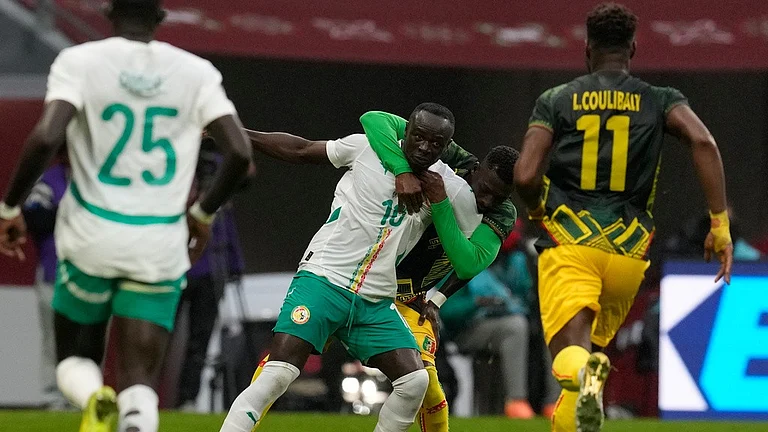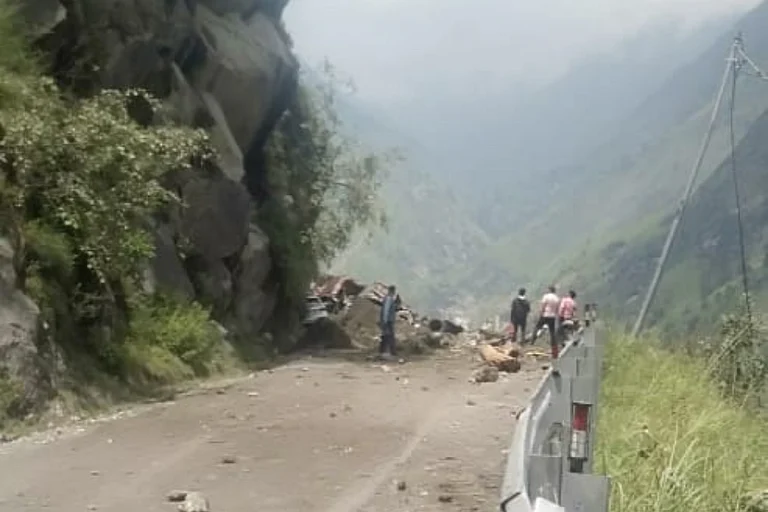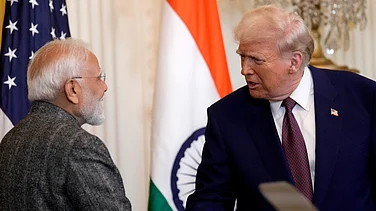On October 23, 1990, a local journalist, Gonu Jha, rang the circuit house in Samastipur at around two in the morning, checking on L K Advani. He found out that the BJP leader was asleep and that his supporters had left. The second information was, of course, all that mattered—the very reason Gonu had made the call. Because he was neither a journalist nor Gonu; he was Lalu Prasad Yadav, then the chief minister of Bihar, determined to stop Advani’s Rath Yatra in a state devastated by recent communal riots. The phone call assured the cops that they wouldn’t have to tear through an army of protesters for their climactic move; the next morning, they arrested Advani.
Nothing about this incident seemed to indicate that the two men were, in fact, political allies. The coalition government at the centre, led by the nascent National Front, had enlisted support from several parties, including the Janata Dal (Yadav) and the BJP (Advani), to edge out the hegemonic Congress. The tactic worked, making V P Singh the prime minister, but not for long: after Advani’s arrest, the BJP pulled out and the government fell.
Advani versus Yadav could be easily termed as Mandir versus Mandal. Singh’s government, wanting to implement the Mandal Commission, had sparked virulent protests across the country. Not long after, Advani launched his Rath Yatra, amplifying his reach among the aggrieved caste Hindus. Yadav, who had risen to power relying on the solidarity between the Muslims and the marginalised castes, had more than one reason to oppose Advani. This ideological divide, notes Paranjoy Guha Thakurta in his book A Time of Coalitions, “collapsed the V P Singh government”.
A coalition government can often resemble a tightrope walk—one misstep can swallow it whole. Just take a look at the mid-90s: Atal Bihari Vajpayee’s alliance couldn’t complete a month; the United Front’s next two governments, helmed by H D Deve Gowda and I K Gujral, couldn’t finish a year. In the late 1970s, the country’s first successful coalition barely lasted two years. Since 1998, however, two alliances—led by the BJP’s National Democratic Alliance (NDA) and the Congress’ United Progressive Alliance (UPA)—have completed three full terms before the BJP sailed to power with a full majority in 2014, continuing its ascent in the next nine years.
To combat that juggernaut, 26 political parties formed a bloc in July 2023 called INDIA (Indian National Developmental Inclusive Alliance). Its first obstacle had a Shakespearian essence: what’s in a name? Bihar’s Chief Minister, Nitish Kumar, disagreed with “INDIA”, as it sounded similar to “NDA”. Sharad Pawar had a different “D” in his mind when he announced the alliance’s name on Twitter, calling it “Democratic” instead of “Developmental”. Rahul Gandhi said this fight was not “between the two political forces” but for “the idea of India”, implying that it was incomplete without “Inclusive”. “INDIA represents the diversity of the country,” says political scientist Uday Chandra of Georgetown University, Qatar. “It cannot be captured by imposing an artificial unity, through either Nehruvian socialism or Moditva.” Besides “reimagining the Union in a pluralistic way”, he adds, it also signals that the ideas of “vikas are many in our society”.
Any coalition, though, must be wary of the contradictions, and INDIA—whose members’ ideologies swing from ultra-Left to Left to Centre to Centre-Right—has already run into a few. Nitish Kumar publicly disagreed on the decision to boycott 14 TV anchors; Congress leader Kamal Nath clashed with M K Stalin on Sanatan Dharma; and, the seat-sharing negotiations threatening to bubble (so much so that there’s little agreement on its timing—whether it should happen before or after the assembly elections in five states). “It is not realistic to expect that all the parties in the alliance will agree on most issues,” says Ayan Guha, a political science professor at Jamia Hamdard. “But the question of credibility will arise if there is an absence of consensus on core issues.” Besides being anti-BJP, he notes, the alliance must “clearly communicate” the “core issues” that shape its “common perspective”.
Such unity may seem tough given one INDIA party dukes it out against the other in more than one state: the Aam Aadmi Party (AAP) versus the Congress in Punjab or the Congress versus the Trinamool Congress (TMC) in West Bengal. INDIA’s success, feels Guha, hinges on the “alignment between its electoral arithmetic and the grand narrative”. But the former, tied to political feuds, can be a challenge, especially as the regional outfits, such as “AAP and TMC, have fought hard to carve out a political space” in their respective states. That’s where a larger narrative justifying a “national coalition” could be crucial, which could outsize the “arithmetical fractures”.
“A desperate BJP” on the other hand, says Chandra, has reverted to its “original agenda of fomenting communal riots” to “harvest votes”, abandoning “all talks of vikas”. A strategy that may impress only “ideological”, not “swing”, voters. “Each opposition party,” he adds, “should fight the BJP on its own turf.” The party’s recent defeat in Karnataka, annulling its presence in south India, does lend credence to such a possibility. The emaciated Congress, clarifies Chandra, should focus on states in “northern and central India—such as Haryana, Rajasthan, Himachal Pradesh, Madhya Pradesh and Chhattisgarh”—where it has enjoyed a “strong regional presence”, and competes for just “specific seats” in Punjab, Maharashtra, Andhra Pradesh, Telangana, Karnataka and Kerala. “The Congress shouldn’t feel there’s a fight to the finish with its own allies,” he says. “The INDIA secretariat can work out the logistics state by state.”
Two states with hefty Lok Sabha representations, however, don’t feature in the INDIA alliance: Andhra Pradesh and Telangana. In September 2022, the Bharat Rashtra Samithi’s (BRS’s) K Chandrashekhar Rao (KCR) met Nitish Kumar in Patna, who had nurtured his own ambition for an anti-BJP alliance, the “Main Front”. When a reporter asked KCR if he’d back Kumar as the prime ministerial candidate, he stuck to a non-committal response, but Kumar got up, wanting to boycott the press conference. An embarrassing (and hilarious) exchange ensued, where Kumar kept saying “arre chaliye” (10 times) and KCR “arre baithiye” (19 times). But more than the BRS’ obvious refusal to join INDIA—it has a direct competitor in Congress in Telangana—the larger politics of these two states hint at the possible complexities of coalitions in the future. Because unlike the chief minister of other south Indian states, who are OBCs, Andhra Pradesh and Telangana leaders (and their rivals) belong to the dominant Reddy, Kamma and Velama castes. So, as opposed to the INDIA alliance, they haven’t pushed for a caste census. These parties have also flip-flopped on other contentious issues, such as demonetisation and farm bills, and have remained indifferent to the Hindutva onslaught, making Andhra Pradesh and Telangana remarkable aberrations in south India. There’s a lot more at stake than politics or ideology: KCR’s daughter, Kavitha, has been accused in the Delhi liquor scam; Amit Shah recently called the Andhra Pradesh government “ridden with corruption”.
“I think the Andhra-Telangana parties should be invited, much as the Bahujan Samaj Party is being courted by the Congress,” says Chandra, while noting the current limitation, such as the imminent Telangana elections. “They can compete in the state [in the Lok Sabha]”—where the BJP is still not an overwhelming force—“in the same way as Congress-CPM in Kerala and Congress-TMC in West Bengal.” In constituencies with a significant BJP presence, he explains, INDIA could work out a seat-sharing arrangement. “An intelligent cocktail of arithmetic and political narrative is the way forward for the INDIA alliance against the electoral juggernaut of the BJP,” says Guha. “The task is enormously difficult, but not impossible.”
(This appeared in the print as 'Coalition Tightrope')


























